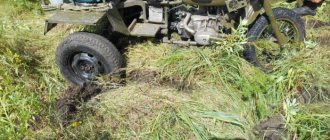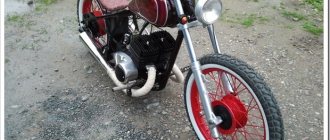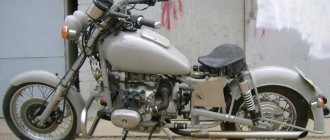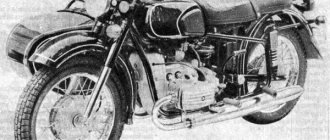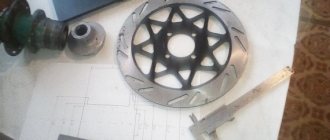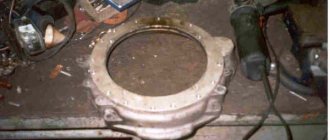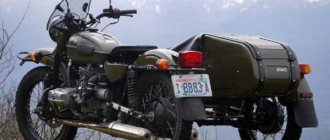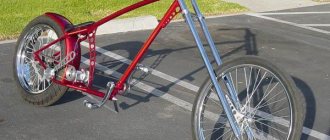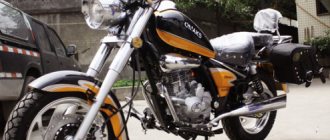Custom motorcycles always looked more impressive and gave their owner much more positive emotions than a regular factory model. The idea of modifying and reincarnating motorcycles appeared back in the 50s. American bikers began to actively remodel their motorcycles, not only painting them in the original color, but also modernizing power units. Some created completely unique models, installing a new exhaust system, beautiful wheels on their motorcycles, modifying the optics, and even such elements as a tank or wings. But what if you try to modify a Soviet motorcycle, for example, Ural or IZH. After thinking a little, we decided to tell you about how to make a chopper from the Urals.
What is a chopper?
First of all, you should understand what motorcycles of this class are. The first choppers appeared in the USA around the 50s. This class became very popular due to the fact that it had a very comfortable seating position, which made traveling on a motorcycle a pleasure. The thing is that the chopper has a high steering wheel, with a clearly inclined front fork. The front wheel of this class of motorcycle is narrow, and the rear wheel is much wider.
Choppers are also distinguished by a small tank and a large engine. And what is important, the very first choppers were made by the same American bikers who created a chopper from an ordinary production motorcycle. Most often these were bikes from the Harley Davidson company, until engineers began producing serial models of Harley choppers.
Choppers are not only a cool and unusual appearance, but also a comfortable ride. The upright riding position allows you to ride a bike like this for quite a long distance before you get tired, which is not the case with sports bikes, for example. But creating a custom chopper with your own hands allows you not only to have a lot of imagination, but also to create a motorcycle just for yourself, which is good news.
Chopper: characteristic features
What distinguishes the chopper most from other motorcycles is its elongated and high handlebars. The rear wing is deep and absent, and some do not have the front wing either. Another insignia is the wide rear wheel or, more correctly, the Great Wide Wheel. That's what bikers call him.
Choppers have a small tank and a characteristic low landing. Driving fast is not for them. Therefore, there is no smell of aggressive dynamics here. This motorcycle is a status motorcycle and is designed for maximum comfort, and not for high-speed rallies.
You can also note soft shock absorbers and high torque, when you can calmly, without straining, drive at high speeds. Its closest “brother” is considered to be the cruiser.
What will you need to build a chopper from the Urals?
Many bikers who have ever thought about building a custom motorcycle have never even tried to get started. The thought that this requires a good understanding of technology, and the whole process is very complicated, completely discourages the desire to create the motorcycle of your dreams. This is completely the wrong approach. In fact, as soon as you start making your first chopper from the Urals, you will realize that everything is actually very simple and you were worrying in vain.
So, in order to make a real chopper out of a Ural motorcycle, we don’t need much. First of all, of course, you need a donor if you don’t already have one. If you are just planning to purchase a Ural motorcycle, then it is better to immediately look for a working bike so as not to waste time. Here it’s worth saying right away why we choose the Ural and not another motorcycle.
Firstly, the Ural is equipped with a fairly powerful engine, which is very similar to the displacement engines of chopper motorcycles. And secondly, the Ural motorcycle has everything we need to build a chopper. Otherwise, apart from spare parts from an old VAZ or ZAZ, we will need practically nothing.
Why do we build self-propelled guns? 8 years from the life of Liter Urals.
Once upon a time, a long time ago, it seems, in another life, in another universe and not at all by me, the construction of the “motorcycle of my dreams” began.
Probably even everything with a capital letter: Dream Motorcycle!
The beginning of this story can be seen Here By 2012, the motorcycle began to look like this:
Let me remind you that the color of the motorcycle was determined by the documents available for it. Documents for 8.103-30…. Green…..1987 year of manufacture)))) More on that later.
An attempt to travel by Litra to Crimea was unsuccessful. Due to problems with carburetors, I had to use a 720 engine. About the trip to Crimea in '12 is written here
By 2013, the motorcycle was running, didn’t break down, and basically made me happy with everything.
The optics were replaced with Voyazhev's, additional light was made by the Demons of Tranquility. They also made mufflers. The first version of direct flows turned out to be very loud. The second version repeated its design, but added flutes inside. The motorcycle has a heated saddle and grips
In the same year, tired of the original drum rear brakes, a bridge from Ural Retro, model 2003, was purchased to install drum hydraulics from a VAZ 2108.
These brakes have been drinking my blood all this time and, not surprisingly, the problem was the terrible quality of domestic parts, starting from the curvature of the drum itself (moulded in 2020) and ending with the pads and brake cylinder produced by LADA parts. At the moment, the pads are Japanese and the cylinder is Italian.
Over time, the motorcycle received a stem from the Wolf, instead of homemade bars like the Ural Voyage. More information about research on the issue of front safety bars on the Ural Wolf is written in this article. The bars work, and they work perfectly. The last time, returning from Kazan in September 2020, the last 100 km. I was driving under a wall of rain, and having over-braked the front end, I stretched out on the Moscow Ring Road, 500 meters from the exit to the house. The motorcycle slid about 10 meters on the asphalt on its side, knocking down only the mirror and scratching the clutch handle.
The motorcycle was overgrown with parts, panniers, windows, custom turn signals, fog lights, etc. The air filter was taken from the late Wolves (frying pan). I really wanted to put a fully chrome-plated barrel from the early Wolves under the Keihin... but it didn’t fit with my tank.
The dashboard, cut out by me with a cobbler's knife! made from a single sheet of aluminum! and spray painted, quickly lost its presentation...
Uncle Kruvl covered it with leather for me. It began to look finished and neat.
At the same time, tired of struggling with the front brakes from IZ Orion, I installed the car and the Bermbo caliper. For this purpose, a spacer for the disc and an adapter for the caliper were made.
Unfortunately, no other photo survived.
Surprisingly, the motorcycle began to slow down! And brake very vigorously. The only thing that bothered me was that when I sharply pressed the brake, the motorcycle dived strongly to the left. The problem was solved later...
The IZH Orion fork itself was assembled on Japanese oil seals, the springs were preloaded with springs from VAZ valves (...it seems they were the ones that were selected from a pile of springs according to the principle of matching diameter...) Imported fork oil was poured into the fork and each blade was pumped up to 4 atmospheres.... After which there were no complaints. So I sold it a few years later. But more on that later.
In the 13th or 14th year, Uncle Seryozha made me a gorgeous wiring harness that runs, works and makes me happy to this day.
Somewhere around this time the timing gears were changed to the Duke.
In 2015, the motorcycle acquired a passenger backrest and a seat for the second number. The backrest from the same Demons of Tranquility was taken as a basis, but the pillow was made independently. The passenger seat was made based on the Ural Wolf saddle. For this purpose, a new adapter base was made from the Ural Retro trunk, and a new padding was made.
Also, the camshaft was replaced with a new one. The so-called injection.
Why don't I write about the gearbox?…. And it was made by Shlans a long time ago and drove almost flawlessly. After playing with the gear ratios in the gearbox, I came up with the idea of a five-speed gearbox with 3rd 1.56, 4th 1.19 and 5th 1:1. She still drives me to this day. There is an idea in my mind to replace the fifth with 1.04….
In this form, the motorcycle went with me to live in Nizhny Novgorod.
In 2016, driving every day through the traffic jams of Nizhny Novgorod, and they there, by the way, are worse than those in Moscow, I was tired of catching a motorcycle diving when braking. And in traffic jams I often had to slow to the floor. We purchased traverses from the Ural Wolf (before that there were traverses from the Demons of Tranquility for the Orion fork), a fork, a wheel and pieces of the wing with mounts from the Ural Voyage, and the merging of all this with the frame from the Wolf and the wing from the M-62 began.
Adapters for new calipers were made, new spacers were installed under the discs, the axle was re-sharpened from the rear one from the Economic Council (the left-hand thread drank blood from turners in NN).
In the Wolf traverse, the holes for mounting the headlights from the Voyage were made through. They began to screw in: a headlight, a bracket for additional light, a tee for hydraulics.
The wing fastening clamps from Voyage (narrower, because on Voyage the traverses are already against the Volkovskys) were welded to the wing of the M-62. The wing has been repainted. Thanks to the two discs at the front, the motorcycle stopped diving to the left. Braking became smooth and linear. The fork from Voyage compared to the IZh Orion fork is like..... scrap. It works very poorly, jerkily, does not absorb small irregularities and is generally terrible... But since then I’ve already gotten used to it.
A new passenger saddle was sewn from scratch. I sewed it myself, on an antediluvian Singer machine (a miracle, not a machine). The old saddle was too narrow (a legacy from the Wolf) and hard. The new one turned out to be much wider and softer. It has become much more convenient for passengers to travel.
I have long wanted to make a tachometer... And I made a tachometer from a Gazelle in a glass from a Ural Wolf speedometer. I installed a USB socket in the place where the Volk tidy was mounted.
The tachometer worked for a couple of weeks, then began to show the weather on Mars, and then completely died...
The other day a replacement arrived from fraternal China. We'll see...
And then......Then the motorcycle just drove...
In 2019, having returned from Nizhny Novgorod back to Moscow, I was puzzled to see what kind of hum had appeared in the engine recently...
It turned out that the timing belt had long ago begun to digest itself. How do you like the gears turning blue from overheating at the camshaft repositioning point?
The reason, firstly, was the race of the front crankshaft bearing. From birth she did not have a spout for watering the timing belt with oil.
The second reason was, oddly enough, Kilowatt…. The smallest particles of the rubber dampers of the Kilowatt drive, of which I replaced a dozen during this time, clogged all the oil channels in the crankcase and the oil traps on the HF. Since the engine never had an oil filter, the result is predictable...
And so, the question arose of rebuilding the engine and installing a normal oil system with an oil filter. The transition to Kilovas components version 5.0 was also carried out. It was promised that it would stop leaking (and it always leaked).
A new crankshaft, flywheel, a complete clutch package from Ural 2019 and a new KV bearing race with a timing spout were purchased. The timing belt was also purchased new. An enlarged (3 liter) pan was also purchased. Tolya 33 ordered a unique one-and-a-half oil pump with an original system for pumping oil to the external circuit for the filter. I will copy the description from the Tolyan topic: A pump with fittings, the same in size as the previous one, the peculiarity is that the oil is pumped to the fitting, and there is a fitting to return the oil back to the engine oil system. Relevant for those who want to install a remote oil filter or radiator. The fittings look backward (in the direction of travel of the motorcycle and back at an angle of 60 degrees into the inside of the crankcase. The thread of the fitting is M14x1.5, material 40X13
A new oil system was installed with copper pipes.
What do you think of this oil intake for the 2019 model year?
An external oil filter is installed.
Didn't it bother you that the motorcycle turned black? And he did!
And all because of the documents for the Economic Council, according to which he was still registered.
In December 2019, a document donor, a 2001 Ural Volk, was purchased. The frame and other parts were disassembled, sandblasted and powder-rolled.
All attachments were repainted black metallic…. because When registering as a donor, I was not allowed to change the color in the documents...
After the next assembly of everything and everyone on the new frame (nothing fit at all, my frame was from the late 00s, and the new one turned out to be 8 years older), everything sounded again, shone and drove as it should.
Do you think this is the end? No, this is just a new beginning! A complete rebuild of the heads is already in the works, a new 89 mm piston with rings from a Mercedes (the old rings were from a diesel Izuzu and did not fit well with this engine) Rebuild of the carburetors, a new flywheel provided the groundwork for installing an injector. What will happen next? Time will tell.
Looking back, I try to mentally understand when did I cross the border of no return, and for so many years now I’ve been building a homemade gun? And most importantly - why? ))))
Chopper from the Urals - start of work
Having selected a decent motorcycle and checked its engine for performance, you can begin to create a motorcycle - the Ural Chopper. All we need to do to create a chopper is to lengthen the front of the bike and work on the rear wheel and suspension. Let's try to break down the construction process step by step.
Drawing
The process will go much faster if you make a drawing or approximate picture of what the resulting motorcycle will look like. There are quite a lot of drawings of chopper frames on the Internet, so choosing the right one will not be so difficult. If you are confident in your abilities, then you can do without it.
Frame
Perhaps the only difficult stage that you will have to face is the alteration and welding of the frame. The whole secret is to place the steering rack at the right angle, which will ultimately change the angle of inclination, allowing you to set the front fork at the required degree. It is worth saying that a lot of attention needs to be paid to welding this place, since this area will receive quite heavy loads.
Having finished with the front fork, you need to work on the rear part of the future motorcycle - Ural Chopper. As a rule, bikes of this class are quite long due to the large rear wheel. That is why we need to weld the frame so that we can install a wide wheel on the axle. Naturally, this part of the frame should also be given a lot of attention. In general, if you have not done welding before, then it is better to entrust this task to specialists, because safety comes first.
Do-it-yourself Ural motorcycle tuning
If you own a Ural motorcycle, but its appearance does not suit you, and you constantly look at foreign handsome men, do not despair. You can improve your vehicle. Most often, they buy a domestic motorcycle just for the shell, and everything else is redone.
Tuning the Ural will take you a lot of time, but it is a very exciting process, and the result will exceed all your expectations.
Before you get started, check out all the proposed upgrades and photos of motorcycles on the Internet.
Having decided, you can begin work. First we redo the rear part of the frame.
- The pendulum needs to be expanded.
- Cut off the seat tubes.
- We weld curved pipes with a diameter of 28 mm, no less. This is not only a beautiful decor, it is also a headscarf amplifier.
- To make the suspension softer, the rear shock absorbers need to be installed at an angle.
- When you put the wide rear wheel in place, make sure that the rubber coupling works without distortion.
- The footrests need to be moved forward, it will be more comfortable for your legs.
- The frame needs to be lengthened by ten centimeters.
- The engine moves backwards.
Perhaps in this case the landing will be incorrect. But for every motorist it is different, individual.
After completing all the work, select a workpiece, perhaps from a stroller, for the rear wing. If you want it to be deeper, you can cut plates from it and butt weld it to the wing.
Let's start working on the tank:
- Use a grinder to remove the glove compartment.
- You also remove the neck and tunnel.
- A wedge is used to cut the top of the tank.
- The two halves are welded at the back. And the neck and tunnel are welded.
- To keep everything sealed, use epoxy resin.
Now we work with the seat:
- You need to cut the base from two-millimeter steel.
- Place thin foam rubber under it.
- The finished structure can be covered with either suede or leather.
The steering wheel needs to be made simple. Everything is cut from a single piece of metal. This is the handle, clutch lever, brakes. For the mirror stand, cut blanks from eight-mm steel. You can buy a housing for a mirror in a store or make it yourself in the form of a sphere.
Silencers are located on the right side.
- Weld the left exhaust pipe without bending it.
- The right pipe remains standard, but it needs to be shortened a little at the top so that the leg does not melt.
- The seams are cleaned, polished and chrome plated.
- To get a chopper sound, you can insert valve springs from a car into the mufflers.
Engines in the Urals can be boosted. When working properly, its power increases to forty-two horsepower.
Ural tuning video
Latest improvements
If you manage to weld a high-quality frame, then you can assume that most of the work has already been done. The only thing I wanted to add was the angle of the front fork. We do not recommend tilting it more than thirty-three degrees. This value is the most optimal for choppers, because the greater the angle of inclination of the front fork, the worse the motorcycle will handle. In our opinion, 28-30 degrees will be more than enough to make the motorcycle look like a real chopper from the Urals, and at the same time handle well.
The last stage is the final assembly of the motorcycle. The engine and other main mechanisms are installed on the frame. The front wheel and handlebars are finally in place and we can see for the first time what our bike looks like after the rework. But in general, the frame is not the only thing that can be done with a Ural motorcycle.
True motorcycle enthusiasts can put all their soul and money into their custom motorcycle, and end up with a Ural Chopper that will delight them for a long time. Installing and reworking the exhaust system, upgrading the fenders, seats, lighting fixtures are just a small part of what can be changed. When modernizing the appearance, you can fully express your imagination or borrow ideas from ready-made choppers.
Budget
So, let's take a closer look at how to make a chopper out of a Ural. The first thing you need to do when deciding to remodel is to count all the necessary materials. Of course, when you have the skill to work with metal, as well as equipment, everything becomes much simpler. But, as a rule, novice motorcyclists have none of this, so the bulk of the money will be spent on material and, of course, on a “donor” motorcycle with all the necessary documents.
Other improvements
Sometimes cups are installed under the tapered bearings, the seat line is lowered (if the frame has been lengthened), the front pipes are lengthened, and so on.
If it is necessary to weld pipes, first of all you need to achieve the strength of the seam. Therefore, it is advisable to practice beforehand in order to learn how to work with electric welding.
A problem may also arise with the evenness of the frame. This needs to be taken very seriously and only after the wheels are rolling, you can cook it.
If inconsistencies appear at the assembly stage, you should not resort to a sledgehammer. Failures happen quite often, but it is best to be patient and ensure that the original actual assembly matches the prepared drawing.
As a last resort, you can leave the work in the hands of professionals. Then the stylish “Ural Chopper”, the photo of which you see, will be at the finish line too.
Frame
This part is very important on any motorcycle, because the type and appearance of the vehicle depend on it. For a chopper, the frame is slightly lengthened and widened for the rear wheel.
At the rear, the length is usually increased by five to fifteen centimeters, depending on the bike itself. Ahead, the need to lengthen arises in order to obtain an “American landing”. Then the control of the brake system and gearbox is transferred to the rod located in front of the engine. But in the case of, for example, the Ural Wolf, this will not be necessary, since it has already implemented exactly this design.
It is best to use the rear wheel no wider than two hundred and ten millimeters so that you do not have to move the driveshaft.
